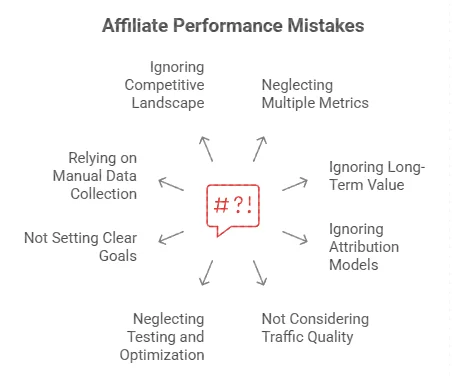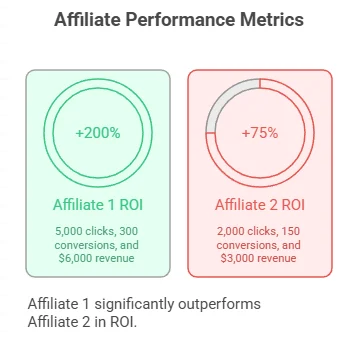
In the competitive world of affiliate marketing, measuring return on investment (ROI) is crucial to understand the effectiveness of your strategies. By keeping track of your affiliate ROI, you can identify which campaigns are thriving and which need adjustments or a complete overhaul. This knowledge empowers you to allocate your resources wisely. Here, we explore effective strategies that can help you accurately measure affiliate ROI.
Understanding Affiliate ROI
Affiliate ROI is a metric that indicates how much revenue an affiliate program generates compared to its costs. The basic formula is:
$$ROI = \left(\frac{\text{Net Profit}}{\text{Cost of Investment}}\right) \times 100$$
This formula helps quantify the success of your affiliate campaigns, guiding you in decision-making and budget allocation.
Key Strategies for Effective Measurement
1. Set Clear Goals
Before diving into measurements, establish what you want to achieve through affiliate marketing. Are you focusing on brand awareness, sales, or leads? Defining your goals clarifies the metrics you’ll track, whether it’s clicks, conversions, or revenue generated.
2. Use Tracking Links
Tracking links allow you to follow user interactions from the point of contact to conversion. Each affiliate should have unique links to ensure you can identify which affiliates are delivering results. Platforms like TrackingDesk offer robust solutions for link generation and tracking.
3. Analyze Traffic Sources
Understanding where your traffic originates is vital. Utilize tools like Google Analytics to track it effectively. By segmenting traffic by source, you gain insights into which channels yield higher ROI, enabling you to focus on the most profitable avenues.
4. Monitor Conversion Rates
Your conversion rate indicates how well your affiliate marketing efforts convert visitors into paying customers. A low conversion rate may suggest a need for improvement in your sales funnel or landing pages. Regularly evaluate these metrics to identify areas for enhancement.
5. Calculate Lifetime Customer Value (LCV)
The Lifetime Customer Value metric helps you assess the total value a customer brings to your business over their lifetime. Use the following formula to calculate LCV:
$$LCV = \text{Average Purchase Value} \times \text{Number of Purchases per Year} \times \text{Average Customer Lifespan (in years)}$$
Understanding LCV is crucial, as it allows you to determine just how much you can spend on affiliate commissions while remaining profitable.
6. Utilize A/B Testing
Conducting A/B tests helps you determine the effectiveness of different approaches. Test variations of your landing pages, ad copies, or email campaigns. By analyzing which version yields better ROI, you can refine your strategies accordingly.
7. Regular Reporting
Implement a routine for your reporting and data analysis. Consider using dashboards that collate important metrics into an easy-to-read format. Tools like Databox can help visualize your progress over time.
Evaluating the Data
Once you gather useful data, look beyond the numbers to understand the story they tell. Use the insights to assess your campaigns. Here’s a simple table to illustrate how you can track and evaluate the campaign data:
| Affiliate Name | Clicks | Conversions | Revenue | ROI (%) |
|---|---|---|---|---|
| Affiliate 1 | 1500 | 300 | $6000 | 200% |
| Affiliate 2 | 2000 | 150 | $3000 | 75% |
Continual Improvement
Regularly review your findings and adapt your strategies according to the trends you uncover. Market demands shift, and your affiliate programs should remain flexible and dynamic to meet changing needs. By implementing these strategies, you can effectively measure and enhance your affiliate ROI , ultimately leading to improved outcomes and profitability.
Key Metrics to Analyze in Affiliate Marketing
In the world of affiliate marketing, understanding key metrics is essential for crafting strategies that convert. By analyzing these metrics, you can fine-tune your campaigns for better payout and higher engagement. Here we will explore the important metrics that every affiliate marketer should track.
Click-Through Rate (CTR)
Your click-through rate reveals how effective your affiliate links are at grabbing attention. It measures the percentage of people who click on your affiliate link compared to the number of people who viewed the link.
$$CTR = \left(\frac{\text{Total Clicks}}{\text{Total Impressions}}\right) \times 100$$
A higher CTR indicates engaging content. If your CTR is low, consider revising your copy or call-to-action (CTA) to better entice readers.
Conversion Rate
The conversion rate gauges how many of your clicks lead to actual purchases or actions. This metric is critical as it directly impacts your earnings. Improving conversion rates can significantly lift your ROI.
$$\text{Conversion Rate} = \left(\frac{\text{Total Conversions}}{\text{Total Clicks}}\right) \times 100$$
To enhance conversion rates, focus on optimizing landing pages to ensure they align with the expectations set in your affiliate content.
Average Order Value (AOV)
This metric calculates the average amount of money a customer spends per order. Higher AOV means more revenue per transaction, which can significantly boost your earnings as an affiliate marketer.
$$AOV = \frac{\text{Total Revenue}}{\text{Total Transactions}}$$
You can increase AOV through upselling or cross-selling related products. For instance, if a customer purchases a camera, recommending a camera bag can be beneficial.
Return on Investment (ROI)
Measuring ROI allows you to determine the profitability of your affiliate efforts. It tells you how much profit you earn for every dollar spent on your marketing campaigns.
$$ROI = \left(\frac{\text{Net Profit}}{\text{Cost of Investment}}\right) \times 100$$
To improve ROI, regularly evaluate each affiliate program you’re involved with. Dropping low-performing programs can enhance overall profitability.
Customer Lifetime Value (CLV)
Understanding customer lifetime value is important. CLV estimates how much revenue a customer will generate during their relationship with your affiliate program. This metric helps in making informed investment decisions.
$$CLV = \text{Average Purchase Value} \times \text{Average Purchase Frequency} \times \text{Customer Lifespan}$$
Increasing CLV involves nurturing relationships with customers. You can do this by providing valuable content, updates, and special offers to encourage repeat purchases.
Traffic Sources

Knowing where your traffic comes from can help you tailor your marketing efforts. Different sources may yield different conversion rates. Common traffic sources include:
- Organic Search
- Paid Ads
- Email Marketing
- Social Media
Use analytical tools like Google Analytics to track your traffic and refine your strategies based on which sources drive conversions.
Bounce Rate
The bounce rate indicates the percentage of visitors who leave your site after viewing only one page. A high bounce rate may signify that your landing page isn’t engaging or relevant to your audience.
$$\text{Bounce Rate} = \left(\frac{\text{Single Page Visits}}{\text{Total Entries}}\right) \times 100$$
To reduce bounce rates, ensure your website’s content is engaging and that your site loads quickly.
Engagement Metrics
Engagement metrics such as average session duration and page views per visit provide insights into how users interact with your site. More engagement often correlates with higher chances of conversion. Key Engagement Metrics:
| Affiliate Name | Clicks | Conversions | Revenue | ROI (%) |
|---|---|---|---|---|
| Affiliate 1 | 1500 | 300 | $6000 | 200% |
| Affiliate 2 | 2000 | 150 | $3000 | 75% |
By closely monitoring these key metrics, you can gain valuable insights into your performance as an affiliate marketer. Additionally, apps like SEMrush can help you track and analyze these metrics effectively while providing actionable recommendations. For a deeper dive into affiliate metrics, refer to resources on AWeber where you’ll find articles that explore optimizing your affiliate marketing strategies based on metrics. These metrics into your analysis will empower you to make data-driven decisions, ultimately leading to increased effectiveness in your affiliate marketing endeavors.
Tools and Software for Tracking Affiliate ROI
Measuring your affiliate ROI accurately is essential for improving your marketing efforts. However, tracking your return on investment can become complex without the right tools. Fortunately, many software options are available to help streamline the process. These tools allow you to track clicks, conversions, and revenue effectively, giving you deeper insights into your performance.
Google Analytics
One of the most popular tools for tracking affiliate ROI is Google Analytics. This powerful platform enables you to monitor your website traffic, including where customers arrive from, and how they engage with your content. By setting up goals, you can see how affiliate links contribute to your overall conversions. Google Analytics integrates well with many affiliate programs, enhancing your tracking capabilities.
ClickMeter
Next, you might consider using ClickMeter. This tool specializes in link tracking, providing detailed reports on each affiliate link’s performance. You’ll receive insights into click-through rates, conversion rates, and ROI for every link you share. ClickMeter helps you optimize your campaigns by pinpointing which affiliates generate the most revenue for your efforts.
Affise
An alternative to ClickMeter is Affise. This platform offers a comprehensive management system for your affiliate program, allowing you to manage affiliates, campaigns, and payments from one dashboard. With real-time tracking and analytics, Affise shows you how each campaign performs, making it easier to adjust strategies and maximize ROI.
Refersion
Furthermore, Refersion is another software solution tailored for affiliate marketing. It allows you to set up and manage your affiliate program smoothly. With its tracking capabilities, you can view your ROI and revenue-per-click metrics, simplifying performance evaluations. This visual representation of data helps you understand your efforts better.
WooCommerce
If you’re looking for a budget-friendly option, WooCommerce paired with affiliate plugins can help you track your sales and ROI without breaking the bank. The integration of plugins allows you to create an affiliate management system directly within your e-commerce site, giving you easy access to sales data.
Tool Comparison
Here’s a brief comparison of these tools:
| Tool | Special Features | Ideal For |
|---|---|---|
| Google Analytics | Website traffic insights, goal tracking | General marketing analysis |
| ClickMeter | Link tracking, conversion analysis | Affiliate marketers focused on links |
| Affise | Program management, real-time data | Affiliates and advertisers |
| Refersion | Affiliate program management | E-commerce sites |
| WooCommerce | Integration with e-commerce | Small business owners |
Klaviyo
You may also want to explore Klaviyo, which combines email marketing and affiliate tracking. It provides robust analysis capabilities for understanding how email campaigns drive affiliate sales. Measuring ROI through multiple channels enhances your ability to make informed decisions based on your entire marketing ecosystem. Understanding these tools will enhance your affiliate marketing performance significantly.
When assessing each option, consider your specific tracking needs, budget, and how well a tool integrates with your existing systems. Ultimately, the right tool will not just track your affiliates but will also provide insights that drive better decisions for your business. Using Affiliate ROI Measurement tools is crucial for the success of your affiliate marketing strategy. Each tool listed has its unique features catering to different needs. By implementing the tool that best fits your marketing strategy, you can gain valuable insights that enhance your ROI and foster stronger partnerships with affiliates.
Common Mistakes in Measuring Affiliate Performance

Measuring affiliate performance accurately is crucial for the success of any affiliate marketing program. However, many marketers make common mistakes that can skew their understanding of the return on investment (ROI) of their affiliate efforts. Recognizing these errors can lead to better decision-making and increased profitability. Here are some common pitfalls to avoid when measuring affiliate performance.
Neglecting to Track Multiple Metrics
One of the most significant mistakes in Affiliate ROI Measurement is focusing solely on a single metric. While it might be tempting to track just clicks or conversions, a more holistic approach yields better insights. Consider these key metrics:
- Clicks: The total number of times users have clicked on your affiliate links.
- Conversions: The number of those clicks that result in sales.
- Revenue: Total income generated from your affiliate sales.
- Cost per Conversion (CPC): Total spend divided by the number of conversions.
- Conversion Rate: The percentage of clicks that resulted in sales (Conversions / Clicks).
By tracking multiple metrics, you can gain a deeper understanding of your strategies and identify areas that require improvement.
Failing to Account for Long-Term Value
Many affiliate marketers mistakenly gauge performance based only on short-term returns. Understanding the long-term value of a customer acquired through an affiliate is essential. This is often referred to as Customer Lifetime Value (CLV). Measuring how much revenue a single customer generates over time can provide insight into the effectiveness of your affiliate partners. To calculate CLV, consider using the formula:
$$CLV = \text{Average Purchase Value} \times \text{Average Purchase Frequency} \times \text{Customer Lifespan}$$
Ignoring Attribution Models
Another common mistake is not adopting proper attribution models. The way you attribute sales and conversions to various marketing channels can greatly affect how you evaluate affiliate performance. Different models, like last-click, first-click, or multi-touch attribution, can lead to very different interpretations of a campaign’s success. Evaluate which model aligns with your marketing goals and apply it consistently to ensure accurate ROI measurement.
Not Considering the Quality of Traffic
While high traffic volume may seem like a success, it doesn’t always translate to better conversions. Affiliates may drive a lot of clicks, but if those visitors are not interested in your product or service, they won’t convert. Therefore, it’s important to review the quality of traffic generated by your affiliates. Tools like Google Analytics can help you track the behavior of visitors who arrive through affiliate links.
Neglecting Ongoing Testing and Optimization
Measuring affiliate performance should be an ongoing process of testing and optimizing your efforts. If you find certain affiliates are underperforming, do not hesitate to try some A/B testing. Experiment with different offers, creatives, or messaging tailored to specific target audiences.
Not Setting Clear Goals
Without clear and actionable goals, measuring affiliate performance can become foggy. Establish specific, measurable, achievable, relevant, and time-bound (SMART) goals for your affiliate marketing initiatives. These goals could relate to revenue targets, conversion rates, or customer acquisition metrics.
Relying on Manual Data Collection
Some marketers incorrectly rely on manual methods to gather performance data. This can lead to inaccuracies and time-consuming processes. Automated tools and reporting solutions, like Post Affiliate Pro or Affise, can streamline the process of affiliate ROI, allowing you to focus on strategy rather than data collection.
Ignoring the Competitive Landscape
Not considering competitors’ affiliate strategies can limit your ability to optimize. Research and analyze industry benchmarks to see how your performance compares. Tools like SimilarWeb or SEMrush can provide insights into competitor performance and trends, enabling you to adapt and improve your own affiliate marketing strategies.
By avoiding these common mistakes, you can significantly improve your efforts in measuring affiliate performance and, ultimately, enhance your ROI. A focus on comprehensive data, quality traffic, long-term value, and continuous optimization will set you on a path of sustainable success in affiliate marketing.
Case Studies: Successful Affiliate ROI Measurement Practices
Measuring the return on investment (ROI) for affiliate marketing is crucial for understanding which campaigns drive profit and which do not. Successful businesses utilize various practices to track, analyze, and optimize their affiliate programs. Here are several case studies showcasing effective Affiliate ROI Measurement practices.
Case Study 1: E-commerce Company
One well-known e-commerce platform faced difficulties in determining the performance of its affiliate programs. By implementing unique tracking links for each affiliate, they gathered accurate data on each affiliate’s performance. This allowed them to identify top-performing affiliates and assess which marketing strategies yielded the best results.
- Implementation: The company created individual links that directed to specific products.
- Measurement: They used a combination of Google Analytics and custom dashboards to track conversions.
- Results: This data-driven approach helped increase ROI by 30% in just six months.
Case Study 2: Online Education Platform
An online education provider sought to amplify its affiliate marketing efforts. They measured affiliate ROI by tying commissions directly to sales from affiliate referrals using a sophisticated tracking software. Instead of a flat-rate commission, they offered performance-based incentives based on the total sales generated.
- Implementation: Updated commission structures made it attractive for affiliates to promote specific courses.
- Measurement: They integrated marketing attribution tools to follow the user journey more accurately.
- Results: This change ultimately led to a 45% increase in affiliate-driven sales.
Case Study 3: A Travel Booking Site
A leading travel booking website was struggling to determine how well its affiliate marketing partnerships were performing across various channels. They adopted a multi-channel tracking approach, using a robust performance management software that captured data across social media, websites, and email promotions.
- Implementation: The team segmented affiliates into categories based on the traffic source.
- Measurement: They focused on lifetime value (LTV) rather than just one-time sales, allowing a better understanding of long-term relationships.
- Results: This method led to 60% higher retention rates for customers referred by affiliates.
Case Study 4: Health and Wellness Brand
A health and wellness company knew the importance of tracking their affiliate ROI to ensure they were partnering with the right influencers. They utilized a combination of social media metrics and sales data to determine which affiliates drove the most conversions.
- Implementation: They conducted surveys to gauge customer awareness and responses to influencer promotions.
- Measurement: The brand regularly adjusted its strategies based on performance reports generated from affiliate activities.
- Results: Over two years, they doubled their affiliate revenue through strategic partnerships with top-performing influencers.
Best Practices for Effective Affiliate ROI Measurement
From analyzing these case studies, several best practices emerge that can benefit businesses looking to refine their affiliate programs:
- Utilize unique tracking links to accurately measure individual affiliate performance.
- Incorporate performance-based commission structures to incentivize affiliates.
- Apply multi-channel tracking to understand where sales are coming from.
- Focus on lifetime value to grasp the long-term impact of affiliate partnerships.
- Regularly review and adjust marketing strategies based on performance analytics.
These strategies not only enhances affiliate ROI but also strengthens affiliate relationships. For further insights and tools for measuring affiliate ROI effectively, consider exploring resources from TUNE and Admitad. Measuring and optimizing affiliate ROI is a continuous journey. By investing in the right tools and strategies, businesses can maximize their affiliate program’s potential, leading to sustainable growth and profitability.
Conclusion
Measuring affiliate ROI effectively is crucial for optimizing your marketing efforts and ensuring you’re getting the most out of your partnerships. By implementing the strategies discussed, you can sharpen your analysis and drive better results.
Understanding key metrics, such as conversion rates, customer acquisition cost, and average order value, will allow you to gauge the effectiveness of your campaigns. Regularly analyzing these indicators is essential for making informed decisions and enhancing your strategy.
Utilizing the right tools and software can simplify tracking your affiliate ROI, providing you with insights that drive performance. From specialized tracking platforms to comprehensive analytics tools, investing in technology can streamline your efforts and reveal valuable data.
Avoiding common pitfalls in measuring affiliate performance is equally important. Many marketers overlook discrepancies in tracking or fail to attribute sales correctly. By being aware of these mistakes, you can create a more reliable measurement strategy.
Real-world case studies serve as powerful examples of successful affiliate ROI practices. Learning from others’ experiences can help you identify what works and what doesn’t in your marketing efforts.
By applying these principles, you can build a robust framework for measuring affiliate ROI. This continuous improvement process not only enhances your strategies but also strengthens your affiliate relationships, leading to sustained growth and profitability. Focus on accuracy, use the right tools, and learn from successful practices to ensure your affiliate marketing efforts deliver measurable returns.
